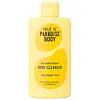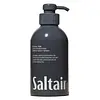Isle of Paradise Brilliantly Bright Body Cleansing Wash with Vitamin C & Niacinamide Versus Saltair Serum Body Wash
What's inside
What's inside
 Key Ingredients
Key Ingredients

 Benefits
Benefits

 Concerns
Concerns

 Ingredients Side-by-side
Ingredients Side-by-side

Glycerin
HumectantCocamidopropyl Betaine
CleansingPolyglyceryl-4 Caprate
EmulsifyingPotassium Cocoyl Glycinate
Acrylates Copolymer
Sodium Cocoamphoacetate
CleansingSodium Chloride
MaskingNiacinamide
SmoothingHydrolyzed Hyaluronic Acid
HumectantAscorbic Acid
AntioxidantPanthenol
Skin ConditioningDaucus Carota Sativa Seed Oil
EmollientPotassium Cocoate
EmulsifyingBetaine
HumectantParfum
MaskingPotassium Benzoate
PreservativeSodium Phytate
Caprylyl Glycol
EmollientButylene Glycol
HumectantCI 77891
Cosmetic ColorantPolymethylsilsesquioxane
Silica
Abrasive1,2-Hexanediol
Skin ConditioningEthylhexylglycerin
Skin ConditioningBenzyl Salicylate
PerfumingGlycerin, Cocamidopropyl Betaine, Polyglyceryl-4 Caprate, Potassium Cocoyl Glycinate, Acrylates Copolymer, Sodium Cocoamphoacetate, Sodium Chloride, Niacinamide, Hydrolyzed Hyaluronic Acid, Ascorbic Acid, Panthenol, Daucus Carota Sativa Seed Oil, Potassium Cocoate, Betaine, Parfum, Potassium Benzoate, Sodium Phytate, Caprylyl Glycol, Butylene Glycol, CI 77891, Polymethylsilsesquioxane, Silica, 1,2-Hexanediol, Ethylhexylglycerin, Benzyl Salicylate
Water
Skin ConditioningCocamidopropyl Betaine
CleansingSodium C16 Olefin Sulfonate
EmulsifyingSqualane
EmollientNiacinamide
SmoothingCarapa Guianensis Seed Oil
Skin ConditioningBertholletia Excelsa Seed Oil
EmollientAscorbyl Glucoside
AntioxidantSodium Hyaluronate
HumectantChlorella Vulgaris Extract
Skin ConditioningCandida Bombicola/Glucose/Methyl Rapeseedate Ferment
AntimicrobialSodium PCA
HumectantOlea Europaea Fruit Oil
MaskingHelianthus Annuus Seed Oil
EmollientPropanediol
SolventMagnesium PCA
HumectantArgania Spinosa Kernel Oil
EmollientZinc PCA
HumectantLithospermum Erythrorhizon Root Extract
Skin ConditioningGlycyrrhiza Uralensis Root Extract
Skin ConditioningAngelica Gigas Root Extract
Skin ConditioningManganese PCA
HumectantLactic Acid
BufferingPhenoxyethanol
PreservativePEG-150 Distearate
EmulsifyingSodium Cocoyl Isethionate
CleansingSodium Benzoate
MaskingCitric Acid
BufferingTetrasodium Glutamate Diacetate
Parfum
MaskingLimonene
PerfumingWater, Cocamidopropyl Betaine, Sodium C16 Olefin Sulfonate, Squalane, Niacinamide, Carapa Guianensis Seed Oil, Bertholletia Excelsa Seed Oil, Ascorbyl Glucoside, Sodium Hyaluronate, Chlorella Vulgaris Extract, Candida Bombicola/Glucose/Methyl Rapeseedate Ferment, Sodium PCA, Olea Europaea Fruit Oil, Helianthus Annuus Seed Oil, Propanediol, Magnesium PCA, Argania Spinosa Kernel Oil, Zinc PCA, Lithospermum Erythrorhizon Root Extract, Glycyrrhiza Uralensis Root Extract, Angelica Gigas Root Extract, Manganese PCA, Lactic Acid, Phenoxyethanol, PEG-150 Distearate, Sodium Cocoyl Isethionate, Sodium Benzoate, Citric Acid, Tetrasodium Glutamate Diacetate, Parfum, Limonene
 Reviews
Reviews

Ingredients Explained
These ingredients are found in both products.
Ingredients higher up in an ingredient list are typically present in a larger amount.
Cocamidopropyl Betaine is a fatty acid created by mixing similar compounds in coconut oil and dimethylaminopropylamine, a compound with two amino groups.
This ingredient is a surfactant and cleanser. It helps gather the dirt, pollutants, and other impurities in your skin to be washed away. It also helps thicken a product and make the texture more creamy.
Being created from coconut oil means Cocamidopropyl Betaine is hydrating for the skin.
While Cocamidopropyl Betaine was believed to be an allergen, a study from 2012 disproved this. It found two compounds in unpure Cocamidopropyl Betaine to be the irritants: aminoamide and 3-dimethylaminopropylamine. High-grade and pure Cocamidopropyl Betaine did not induce allergic reactions during this study.
Learn more about Cocamidopropyl BetaineNiacinamide is a multitasking form of vitamin B3 that strengthens the skin barrier, reduces pores and dark spots, regulates oil, and improves signs of aging.
And the best part? It's gentle and well-tolerated by most skin types, including sensitive and reactive skin.
You might have heard of "niacin flush", or the reddening of skin that causes itchiness. Niacinamide has not been found to cause this.
In very rare cases, some individuals may not be able to tolerate niacinamide at all or experience an allergic reaction to it.
If you are experiencing flaking, irritation, and dryness with this ingredient, be sure to double check all your products as this ingredient can be found in all categories of skincare.
When incorporating niacinamide into your routine, look out for concentration amounts. Typically, 5% niacinamide provides benefits such as fading dark spots. However, if you have sensitive skin, it is better to begin with a smaller concentration.
When you apply niacinamide to your skin, your body converts it into nicotinamide adenine dinucleotide (NAD). NAD is an essential coenzyme that is already found in your cells as "fuel" and powers countless biological processes.
In your skin, NAD helps repair cell damage, produce new healthy cells, support collagen production, strengthen the skin barrier, and fight environmental stressors (like UV and pollution).
Our natural NAD levels start to decline with age, leading to slower skin repair, visible aging, and a weaker skin barrier. By providing your skin niacinamide, you're recharging your skin's NAD levels. This leads to stronger, healthier, and younger looking skin.
Another name for vitamin B3 is nicotinamide. This vitamin is water-soluble and our bodies don't store it. We obtain Vitamin B3 from either food or skincare. Meat, fish, wheat, yeast, and leafy greens contain vitamin B3.
The type of niacinamide used in skincare is synthetically created.
Learn more about NiacinamideParfum is a catch-all term for an ingredient or more that is used to give a scent to products.
Also called "fragrance", this ingredient can be a blend of hundreds of chemicals or plant oils. This means every product with "fragrance" or "parfum" in the ingredients list is a different mixture.
For instance, Habanolide is a proprietary trade name for a specific aroma chemical. When used as a fragrance ingredient in cosmetics, most aroma chemicals fall under the broad labeling category of “FRAGRANCE” or “PARFUM” according to EU and US regulations.
The term 'parfum' or 'fragrance' is not regulated in many countries. In many cases, it is up to the brand to define this term.
For instance, many brands choose to label themselves as "fragrance-free" because they are not using synthetic fragrances. However, their products may still contain ingredients such as essential oils that are considered a fragrance by INCI standards.
One example is Calendula flower extract. Calendula is an essential oil that still imparts a scent or 'fragrance'.
Depending on the blend, the ingredients in the mixture can cause allergies and sensitivities on the skin. Some ingredients that are known EU allergens include linalool and citronellol.
Parfum can also be used to mask or cover an unpleasant scent.
The bottom line is: not all fragrances/parfum/ingredients are created equally. If you are worried about fragrances, we recommend taking a closer look at an ingredient. And of course, we always recommend speaking with a professional.
Learn more about Parfum